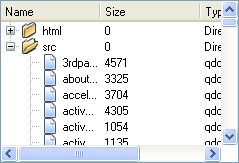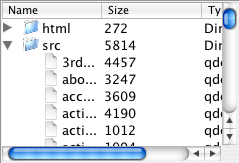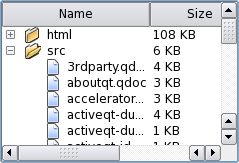| Home · All Classes · Main Classes · Grouped Classes · Modules · Functions |
The QTreeView class provides a default model/view implementation of a tree view. More...
#include <QTreeView>
Inherits QAbstractItemView.
Inherited by QTreeWidget.
The QTreeView class provides a default model/view implementation of a tree view.
A QTreeView implements a tree representation of items from a model. This class is used to provide standard hierarchical lists that were previously provided by the QListView class, but using the more flexible approach provided by Qt's model/view architecture.
The QTreeView class is one of the Model/View Classes and is part of Qt's model/view framework.
QTreeView implements the interfaces defined by the QAbstractItemView class to allow it to display data provided by models derived from the QAbstractItemModel class.
It is simple to construct a tree view displaying data from a model. In the following example, the contents of a directory are supplied by a QDirModel and displayed as a tree:
QDirModel *model = new QDirModel;
QTreeView *tree = new QTreeView(splitter);
tree->setModel(model);
The model/view architecture ensures that the contents of the tree view are updated as the model changes.
Items that have children can be in an expanded (children are visible) or collapsed (children are hidden) state. When this state changes a collapsed() or expanded() signal is emitted with the model index of the relevant item.
The amount of indentation used to indicate levels of hierarchy is controlled by the indentation property.
Headers in a tree view are constructed using the QHeaderView class and can be hidden using header()->hide().
QTreeView supports a set of key bindings that enable the user to navigate in the view and interact with the contents of items:
| Key | Action |
|---|---|
| UpArrow | Moves the cursor to the item in the same column on the previous row. If the parent of the current item has no more rows to navigate to, the cursor moves to the relevant item in the last row of the sibling that precedes the parent. |
| DownArrow | Moves the cursor to the item in the same column on the next row. If the parent of the current item has no more rows to navigate to, the cursor moves to the relevant item in the first row of the sibling that follows the parent. |
| LeftArrow | Hides the children of the current item (if present) by collapsing a branch. |
| RightArrow | Reveals the children of the current item (if present) by expanding a branch. |
| PageUp | Moves the cursor up one page. |
| PageDown | Moves the cursor down one page. |
| Home | Moves the cursor to an item in the same column of the first row of the first top-level item in the model. |
| End | Moves the cursor to an item in the same column of the last row of the last top-level item in the model. |
| F2 | In editable models, this opens the current item for editing. The Escape key can be used to cancel the editing process and revert any changes to the data displayed. |
 |  |  |
| A Windows XP style tree view. | A Macintosh style tree view. | A Plastique style tree view. |
See also QListView, QTreeWidget, Model/View Programming, QAbstractItemModel, and QAbstractItemView.
This property holds indentation of the items in the tree view.
This property holds the indentation measured in pixels of the items for each level in the tree view. For top-level items, the indentation specifies the horizontal distance from the viewport edge to the items in the first column; for child items, it specifies their indentation from their parent items.
Access functions:
This property holds whether the items are expandable by the user.
This property holds whether the user can expand and collapse items interactively.
Access functions:
This property holds whether to show controls for expanding and collapsing items.
This property holds whether root items are displayed with controls for expanding and collapsing them.
Access functions:
This property holds whether all items in the treeview have the same height.
This property should only be set to true if it is guaranteed that all items in the view has the same height. This enables the view to do some optimizations.
Access functions:
Constructs a table view with a parent to represent a model's data. Use setModel() to set the model.
See also QAbstractItemModel.
Destroys the tree view.
Collapses the model item specified by the index.
See also collapsed().
This signal is emitted when the item specified by index is collapsed.
Returns the column in the tree view whose header covers the x coordinate given.
Informs the tree view that the number of columns in the tree view has changed from oldCount to newCount.
This slot is called whenever a column has been moved.
This function is called whenever column's size is changed in the header. oldSize and newSize give the previous size and the new size in pixels.
Returns the horizontal position of the column in the viewport.
Returns the width of the column.
See also resizeColumnToContents().
Lays out the items in the tree view.
Draws the branches in the tree view on the same row as the model item index, using the painter given. The branches are drawn in the rectangle specified by rect.
Draws the row in the tree view that contains the model item index, using the painter given. The option control how the item is displayed.
See also QStyleOptionViewItem() and setAlternatingRowColors().
Expands the model item specified by the index.
See also expanded().
This signal is emitted when the item specified by index is expanded.
See also setExpanded().
Returns the header for the tree view.
See also setHeader() and QAbstractItemModel::headerData().
Hides the column given.
See also showColumn() and setColumnHidden().
Returns the horizontal offset of the items in the treeview.
Note that the tree view uses the horizontal header section positions to determine the positions of columns in the view.
Reimplemented from QAbstractItemView.
See also verticalOffset().
Returns the model index of the item above index.
Returns the model index of the item below index.
Returns the size hint for the row indicated by index.
See also sizeHintForColumn() and uniformRowHeights().
Returns true if the column is hidden; otherwise returns false.
See also hideColumn() and isRowHidden().
Returns true if the model item index is expanded; otherwise returns false.
Returns true if the item in the given row of the parent is hidden; otherwise returns false.
See also setRowHidden() and isColumnHidden().
Move the cursor in the way described by cursorAction, using the information provided by the button modifiers.
Reimplemented from QAbstractItemView.
Resizes the column given to the size of its contents.
Informs the view that the rows from the start row to the end row inclusive are about to removed from the given parent model item.
Reimplemented from QAbstractItemView.
Informs the view that the rows from the start row to the end row inclusive have been inserted into the parent model item.
Reimplemented from QAbstractItemView.
Informs the view that the rows from the start row to the end row inclusive have been removed from the given parent model item.
This function was introduced in Qt 4.1.
Scrolls the contents of the tree view by (dx, dy).
Reimplemented from QAbstractScrollArea.
Scroll the contents of the tree view until the given model item index is visible. The hint parameter specifies more precisely where the item should be located after the operation. If any of the parents of the model item are collapsed, they will be expanded to ensure that the model item is visible.
Reimplemented from QAbstractItemView.
Selects all the items in the underlying model.
Reimplemented from QAbstractItemView.
If hide is true the column is hidden, otherwise the column is shown.
See also isColumnHidden(), hideColumn(), and setRowHidden().
Sets the item referred to by index to either collapse or expanded, depending on the value of expanded.
See also expanded() and expand().
Sets the header for the tree view, to the given header.
The view takes ownership over the given header and deletes it when a new header is set.
See also QAbstractItemModel::headerData().
If hide is true the row with the given parent is hidden, otherwise the row is shown.
See also isRowHidden() and setColumnHidden().
Applies the selection command to the items in or touched by the rectangle, rect.
Reimplemented from QAbstractItemView.
See also selectionCommand().
Shows the given column in the tree view.
See also hideColumn() and setColumnHidden().
Returns the size hint for the column's width or -1 if there is no model.
If you need to set the width of a given column to a fixed value, call QHeaderView::resizeSection() on the view's header.
If you reimplement this function in a subclass, note that the value you return is only used when resizeColumnToContents() is called. In that case, if a larger column width is required by either the view's header or the item delegate, that width will be used instead.
Reimplemented from QAbstractItemView.
See also QWidget::sizeHint and header().
Sorts the model by the values in the given column.
Returns the vertical offset of the items in the tree view.
Reimplemented from QAbstractItemView.
See also horizontalOffset().
Returns the rectangle on the viewport occupied by the item at index. If the index is not visible or explicitly hidden, the returned rectangle is invalid.
Reimplemented from QAbstractItemView.
Returns the rectangle from the viewport of the items in the given selection.
Reimplemented from QAbstractItemView.
| Copyright © 2006 Trolltech | Trademarks | Qt 4.1.3 |